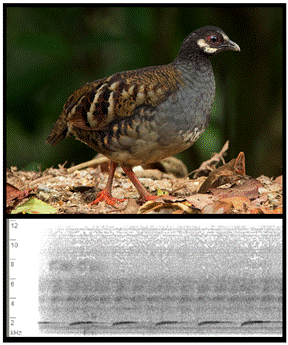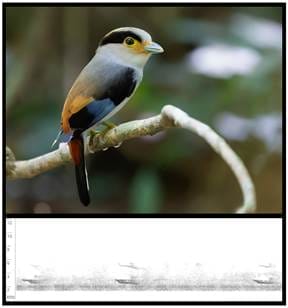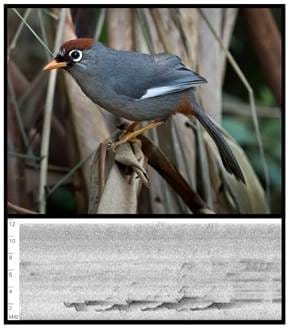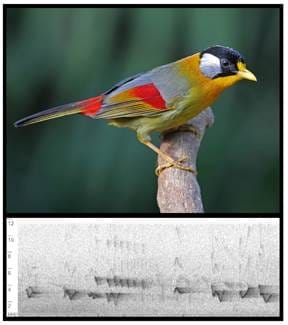By Ana Gabrielle Alcantara
Last June 2024, representatives from the Wild Bird Club of the Philippines participated in the Fraser’s Hill International Bird Race 2024, the oldest bird race in Malaysia. As one of the participants, I was able to experience Malaysia’s biodiversity firsthand and discover how the region’s diverse habitats support a large variety of bird species.
This was my very first bird race—and what an exhilarating adventure it was! Having only ever birdwatched in the Philippines and studied the country’s endemic birds, spotting foreign birds was both exciting and surreal. Like echoes of something I thought I knew, these Malaysian birds were simultaneously familiar and unfamiliar.
Reading up on a topic is completely different from experiencing it personally. Birding in an entirely new region introduced me to a symphony of songs I had never heard before. I found myself wondering: what are the signature melodies of the star birds of Fraser’s Hill?
This article focuses on the top ten notable birds found in Fraser’s Hill, Malaysia. Through this guide, both beginner and veteran birdwatchers would gain insight into the basic field identification as well as the vocal repertoire of Fraser’s Hill avian chorus. After all, birdsong has a unique ability to emotionally connect people, no matter their nationality, to the environment. It manages to overcome a language barrier to persistently draw individuals into the natural world.
1. Malayan Partridge Arborophila campbelli
The Malayan Partridge, also known as Malaysian Partridge and Sang Serok Gunung in Malay, is one of the star birds in Fraser’s Hill. Endemic to the Malay Peninsula, it is a local resident to areas above 1000m and may be seen scurrying along forest and gully floors.1,2
It has prominent white cheeks, forecrown, and neck patches on a dark head. Its beak is black; its upper body is brown with grey underparts; its wings have black and rufous bars on the flanks and its legs are reddish.1,2
Call sequences consist of low-pitched rhythmic drones. The most frequently heard vocalization from the Malayan Partridge is a rising di-syllabic whistle, rendered as wut-wut, wut-wut. This call can be sung by pairs as an antiphonal communication wherein one bird responds to the di-syllabic whistle in order to create a repetitive rhythm of sounds. Other calls include low and more subdued wut-wit, wut-wit seen during foraging behavior.2

A photo of the Malayan Partridge and a spectrogram of its call wut-wut, wut-wut. Photo credit to Ayuwat Jearwattanakanok (ML127951241). Audio credit to Pieter de Groot Boersma (ML203886611).
2. Silver-breasted Broadbill Serilophus lunatus
Also called Takau Dada Perak and Burung Tadah Hujan by locals, the Silver-breasted Broadbill can be found in the Himalayas, southern China, Sumatra, and parts of Southeast Asia and the Malay Peninsula. It is a common resident to altitudes of 200 to 1200m in forests and forest edges.2
It is known for its black supercilium, whitish-gray crown, pale blue beak, and yellow orbital skin. Its wings are black with blue patches, with a long, black tail attached to a white breast and belly. Females have a narrow white breast band which is absent in males.2,3
This bird utters clear whistle-tunes when perched, which renders as pee-yu2 or teelee.3This call tends to be composed of a single note which may slightly downslur towards the end, and repeats at an even pace.

A photo of the Silver-breasted Broadbill and a spectrogram of its call pee-yu. Photo credit to Ayuwat Jearwattanakanok (ML598091621). Audio credit to Gary Leavens (ML612855162).
3. Long-tailed Broadbill Psarisomus dalhousiae
The name “Long-tailed Broadbill”, locally referred to as Takau Ekor Panjang, is derived from the bird’s diagnostic long, blue tail against green plumage, and black-and-yellow head color scheme. It can be found in the Himalayas, Myanmar, certain parts of Southeast Asia, the Malay Peninsula, Sumatra, and Borneo. It commonly resides in 820-1500m forest elevation.2,4
The calls heard most often from the Long-tailed Broadbill are five to eight series of monosyllabic or di-syllabic notes. Each high-pitched whistle note slightly descends at an even pace and is rendered as pseeu-pseeu-pseuuu. It can also elicit a raspy call pseeup.2,4

A photo of the Long-tailed Broadbill and a spectrogram of its call pseeu-pseeu-pseuuu. Photo credit to Enrico Legaspi. Audio credit to Arthur Gomes (ML616460869)
4. Red-headed Trogon Harpactes erythrocephalus
Standing out with its striking red plumage, the Red-headed Trogon or Kesumba Kepala Merah in Malay, is one of the celebrated birds in Fraser’s Hill. The species is found to inhabit a wide geographical range, including the eastern Himalayas, southern China, Southeast Asia and Sumatra. It occupies forests of above 700m, often seen in middle-storey perches.2,5
While male Red-headed Trogons exhibit the distinctive red coloration on the head and belly, females possess a brownish cinnamon head and breast, and faded red belly. Both males and females have blue orbital rings, a white crescent patch across the chest, and black-and-white tail pattern.2,5
Vocalizations of male Red-headed Trogons consist of five to six descending dulcet whistles and are transliterated as tiaup…tiaup…tiaup. They also produce buzzy and rattling sounds of twirrrr.2

A photo of the Red-headed Trogon and a spectrogram of its call tiaup…tiaup…tiaup. Photo credit to Ayuwat Jearwattanakanok (ML127950521). Audio credit to Esha Munshi (ML543867211).
5. Common Green-Magpie Cissa chinensis
Locally known as Megpai Hijau (“green magpie”) and Gagak Gunung (“mountain crow”),the Common Green Magpie is easily recognized by its black eyeline, yellow crown, red bill, chestnut wings and red legs across bright green plumage.2,6
The species ranges from the Himalayas, Myanmar, Southeast Asia, Sumatra and Borneo. It is commonly found in forests and forest edges above 900m.2,6
One of the more vocal birds in this list, the Common Green Magpies are known to give a series of noisy, loud, and metallic whistle calls, rendered as kleeep2 or chup6 sounds. Other vocalizations include fast and grating buzzy calls.

A photo of the Common Green-Magpie and a spectrogram of its call kleeep. Photo credit to Steve Bale (ML136424471). Audio credit to Charlie Andrews (ML463676591).
6. Collared Owlet Taenioptynx brodiei
The Collared Owlet, locally named Pungguk Kerdil Bercekak, derived its name from its small stature and buff nape collar. Its brown, round head is dotted with white spots. Its brown body is lined with rufous buff bars.2,7
It is located in the Himalayas, southern China, Southeast Asia, Sumatra and Borneo. It is found in elevations of 700 to 1800m in certain mountain ranges. It prefers the lower-storey canopy of forests and forest edges.2,7
Its call is a series of monotonous hoots indefinitely sung for an extended period. Rendered as ponk, ponk-ponk-ponk, a slight pause separates the initial note from the succeeding two to three notes.2

A photo of the Collared Owlet and a spectrogram of its call ponk, ponk-ponk-ponk. Photo credit to Cheng-Ru Tsai (ML540414451). Audio credit to Ramit Singal (ML97627191).
7. Chestnut-capped Laughingthrush Pterorhinus mitratus
The Chestnut-capped Laughingthrush, also known as Spectacled Laughingthrush or Kekicau-Riang Mata Putih in Malay, is among Fraser’s Hill’s most vocal and recognizable species. It is aptly named for dark chestnut cap, orange bill, white eyering, and white forehead streaks on a dark head. Its bluish-grey plumage contrasts the white wingbars on its side and the chestnut undertail coverts.2
This bird occurs in the Malay Peninsula, Sumatra, and Borneo It lives in a variety of natural habitats, including forest and forest edges, and prefers moving along thick coverages of branches. This species can be commonly found in elevations between 1200 to 1400m. Like other laughingthrushes, it enjoys moving about in the thick foliage from branches to branches.2
This bird tends to be vocally active. The Chestnut-capped Laughingthrush’s song—often described as kwo- kwee-kwo-kwee…—is composed of distinctly loud and penetrating phrases of slurred whistles.2 Other calls include harsh raspy notes transliterated as nyehnyehnyehnyeh, which is often associated as a contact call among the moving flock.8

A photo of the Chestnut-capped Laughingthrush and a spectrogram of its call kwee-kwo-kwee. Photo credit to Lars Petersson (ML206128881). Audio credit to Matthias Alberti (ML616514947).
8. Fire-tufted Barbet Psilopogon pyrolophus
This bird, commonly known as Fire-tufted Barbet and locally called Takur Jumbai-Api or Takur Api in Malay, gets its name from its distinct black-and-red feather tufts that resemble flames.2 The Fire-tufted Barbet has large silver cheeks and forehead against a large, light green beak with black markings at the center. Its emerald body is marked with a prominent black chinstrap.9
Its home range is throughout the Malay Peninsula and Sumatra and is commonly found in forest and forest edges between 900 to 1500m.
Its typical call is reminiscent of a car engine, wherein the notes gradually speed up over time.2,9 This series of buzzing trills accelerates and ascends in pitch before dying out towards the end.2 It is also known to create sharp, high-pitched clicks kik2that are said to be associated with courtship display.10

A photo of the Fire-tufted Barbet and a spectrogram of its buzzing call. Photo credit to Ana Gabrielle Alcantara. Audio credit to Ian Davies (ML189485511).
9. Silver-eared Mesia Leiothrix argentauris
The Silver-eared Mesia has a local name of Mesia Telinga Perak, which literally translates respectively into “mesia”, “ear” and “silver”, emphasizing the striking plumage coloration of the bird. This bird has a broad geographical range, which spans from the Himalayas, through parts of Southeast Asia, Malay Peninsula, and Sumatra. It is a common resident of forest and forest edges with altitudes above 900m, preferring to inhabit lower and middle-storey forest layers.2
One of the most distinctive birds in Fraser’s Hills, its prominent feature of silvery white ear coverts makes the bird stand out, as do its other features of black head and yellow bill. The upper and undertail coverts of males and females are red and dull orange-yellow respectively.2,11
The song of the Silver-eared Mesia is a medley of rolling whistles, wherein the call phrases commonly consist of three to five slurred whistle notes. Each note is different, consisting of varying pitch patterns: upslurs, downslurs, overslurs, and underslurs. Aside from pure whistles, it is also seen to be capable of sharp rattle clicks as contact calls and low-pitched chuckling sounds for communication.2

A photo of the Silver-eared Mesia and a spectrogram of its slurred whistles. Photo credit to Luke Seitz (ML89715101). Audio credit to Dibyendu Ash (ML614331127).
10. Sultan Tit Melanochlora sultanea
Referred to as Sultan tit globally and Serai Sultan or Serai Raja in Malay, this bird’s name fits well due to its regal appearance and countenance.2 The yellow crown, crest, belly, and undertails across a dark silhouette are pretty diagnostic features of this bulbul species. The Sultan tit is sexually dimorphic, wherein the males have black head and breast while the females have a dark olive coloration instead.2,12
Its distribution ranges from the Himalayas, southern China, Southeast Asia towards Sumatra. It frequents forest and forest edges from low elevations to as high as 1580m.2
Vocalizations of the Sultan Tit is a piercing whistle rendered as peeo peeo peoo peoo peoo, often associated with a territorial song.2

A photo of the Sultan Tit and a spectrogram of its call— peeo peeo peoo peoo peoo. Photo credit to Enrico Legaspi. Audio credit to Sandip Das (ML535990041).
All in all, the birds of Fraser’s Hill offer something more than just visual displays, they demonstrate the interplay between Malaysia’s diverse habitat and its wildlife. Through their distinctive songs, these birds add an immersive and transformative aspect of birding in this location, truly making it a unique experience for newcomers and veterans alike. As ambassadors of Fraser’s Hill, these birds and their songs create a lasting impression and offer a shared global birding experience that transcends cultures and languages.
References
(1) Malayan Partridge – eBird. https://ebird.org/species/gybpar3 (accessed 2024-09-17).
(2) Jeyarajasingam, A. A Field Guide to the Birds of Peninsular Malaysia and Singapore, 2nd ed.; Oxford University Press: Oxford ; New York, 2012.
(3) Silver-breasted Broadbill – eBird. https://ebird.org/species/sibbro3 (accessed 2024-09-17).
(4) Long-tailed Broadbill – eBird. https://ebird.org/species/lotbro1 (accessed 2024-09-22).
(5) Red-headed Trogon – eBird. https://ebird.org/species/rehtro1 (accessed 2024-09-22).
(6) Common Green-Magpie – eBird. https://ebird.org/species/gremag1 (accessed 2024-09-22).
(7) Collared Owlet – eBird. https://ebird.org/species/colowl1 (accessed 2024-09-22).
(8) Chestnut-capped Laughingthrush – eBird. https://ebird.org/species/chclau3 (accessed 2024-09-23).
(9) Fire-tufted Barbet – eBird. https://ebird.org/species/fitbar1 (accessed 2024-09-22).
(10) ML70285 – Fire-tufted Barbet – Macaulay Library. https://macaulaylibrary.org/asset/70285 (accessed 2024-09-23).
(11) Silver-eared Mesia – eBird. https://ebird.org/species/siemes1 (accessed 2024-09-21).
(12) Sultan Tit – eBird. https://ebird.org/species/sultit1 (accessed 2024-09-22).
